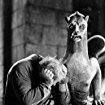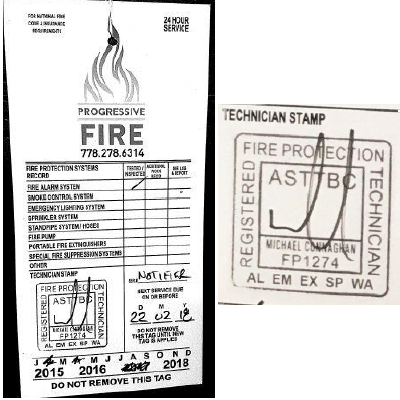Tech-News & Views
“Early in life I had noticed that no event |
|
|||||||||||||||||||||||||||||||||
MERRY CHRISTMAS!Vancouver,B.C. - Here’s wishing all our readers, a very Merry Christmas, Happy Holidays, and an incredible New Year!!
REMINDER! MAJOR KIDDE RECALLS!
HEADS UP! EST (CHUBB-EDWARDS) CONTROLS THAT UTILIZE BELLS!Vancouver, British Columbia - We’re still seeing a lot of EST Quickstart, EST-2, EST-3, and Fireshield controls that utilize NACs (Notification Appliance Circuits) connected to bells and certain models of horns without the proper protection. Please ensure that you look over the Technical Bulletin and identify those systems you service for some extra-special attention. The addition of the TVS Diode (Edwards Part Number 235196P) is critical to the long-term health of some early version power supplies. This issue came to light several years ago and we’ve noted that the Fireshield product appears to be one of the more popular replacement panels for older model fire alarm systems that employed Edwards 6616, 6500, and 2280 series controls. RTFM (Read the Freakin’ Manual)! Fireshield is NOT DESIGNED to run bells!
2018 - A CHALLENGING YEAR AHEAD IN BUILDING LIFE SAFETY!Vancouver, British Columbia - Building life safety service providers are going to have to contend with a number of critical changes to the way inspection, testing, and maintenance has to be performed when the 2015 published editions of our National Fire and Building Codes are adopted in many jurisdictions across Canada in 2018. One of the Provinces in which this is going to occur is British Columbia. Most technicians of my acquaintance are going to be ill prepared, which means that many contractors, building owners and operators are going to find compliance with the Codes and Standards almost impossible to achieve. And they’re not the only ones that are going to be hard-pressed to find technically proficient individuals that will be able to successfully navigate and manage the new requirements 2018 is going to herald. The Engineering community, building officials and jurisdictional authorities face an even bigger challenge when new permits incorporate NBC 2015 and the confusing plethora of new life safety equipment, installation, testing and inspection Standards. So here’s a quick run-down of the Canadian Standards that are going to be referenced in NBCC 2015: CAN/ULC-S527:2011 (Amendment 1) - Standard for Control Units for Fire Alarm Systems (I should mention that a number of the above referenced Standards are included in a specially priced package that’s available through this website.) When you look at the publication dates of the above referenced Standards, the reader will quickly discern the challenges CENTRAL to an approval for occupancy of any new project designed to NBCC 2015, namely: How do you VERIFY a fire alarm installation where a number of key requirements have NO TESTING CRITERIA in the referenced testing and inspection Standard? How do you identify a suitable individual that will formulate the criteria for testing equipment and systems INTEGRATED AND CONTROLLED by the fire alarm system? Should the individual providing the CAN/ULC-S537:2013 Appendix “C” be involved? |
|
|||||||||||||||||||||||||||||||||
|
When interconnected smoke alarms are being used to provide an audible warning of a sprinkler trip, how are you going to ensure the system operates during a power failure? NFPA 25 (2008 & 2011) requires the permanent installation of a Forward Flow Test Header in order to ensure subsequent ANNUAL TESTING of the back-flow prevention device can be performed. How do you install, operate, and test smoke detectors in lieu of smoke alarms, and what signals should they provide to the Fire Signal Receiving Centre when they activate? Here’s a list of the Canadian Standards that are going to be referenced in NFCC 2015: CAN/ULC-S540:2013 - Standard for Residential Fire and Life Safety Warning Systems: Installation, Testing, Inspection and Maintenance NFCC 2015 will raise a whole set of its own challenges, namely: How do you identify qualified personnel to perform the maintenance and inspection of interconnected smoke alarms? How do you identify an individual qualified to perform INTEGRATED TESTING of building life safety systems? What form should be used to document the testing of a smoke control system? What form should be used to document the proper testing of a sprinkler system? Kitchen suppression system? Outdoor fire alarm annunciator installation? Fire Signal Receiving Centre transmitter? These, and many more questions are going to need definitive answers and the trained, qualified professionals that will ensure these (and other) critical systems are properly tested, and will operate when required. Many jurisdictions have only now started searching for answers. You’ll find a whole bunch of them at www.firetechs.net!
COUNTERFEIT ASTTBC RFPT STAMP IN CIRCULATION!Surrey, British Columbia - ASTTBC has issued a “Notice to Authorities Having Jurisdiction” informing them of a previously Registered Fire Protection Technician who is performing inspection and testing on life safety equipment in the Lower Mainland using a counterfeit ASTTBC stamp. The notice states that Michael Connaghan was removed from the ASTTBC RFPT register on August 7, 2012. At the time he had endorsements in Fire Extinguishers (EX), Special Suppression Systems (SP), and Water-Based Fire Protection Systems (WA). The Progressive Fire tag was discovered on a Notifier fire alarm panel by a vigilant Richmond (BC) Fire Prevention Officer last year. It was stamped with a fake ASTTBC seal bearing Mr. Connaghan’s name and previous FP number - FP1274 - which featured two additional endorsements: Fire Alarm (FA), and Emergency Lighting (EM).
Building owners and Property Managers in the Lower Mainland are urged to inspect the tags on their life safety equipment. Please call your local Fire Department’s non-emergency line if Progressive Fire 778.278.6314 is on the face along with an ASTTBC RFPT stamp in the name of Michael Connaghan FP1274 AL EM EX SP WA. Progressive Fire’s telephone number is no longer in service. January 11, 2012 - ASTTBC Notice to Authorities Having Jurisdiction - FP - Michael Connaghan (FP1274) by Frank Kurz on Scribd
VANCOUVER’S VBBL 2014 AMENDMENTS WILL IMPACT NEW FIRE ALARM SYSTEM INSTALLATIONS!Vancouver, British Columbia - January 1st, 2018 is the day that a new amendment to By-law 11996 comes into effect. There are a number of changes to VBBL 2014, but the two really significant ones we want to focus on deal with fire alarm installation. They’re incorporated in two key substitutions: “In Book I, Division B, Part 3, Article 1.3.1.2., in Table T-1.3.1.2., Council: ... f) strikes out
and substitutes the following
, and g) strikes out
and substitutes the following
Need Appendix “C” Reports? Visit our FORMS page and download either the MS Word or PDF file! If you’re installing an addressable fire alarm system IN Vancouver, then you should take a look at our TOOLS page where we feature a wall-mounted fire alarm device installation guide and wiring layouts for Data Communication Link Class “A” and Class “B” circuits. Let the games begin!
QUICK LINKS!AHJ Training Courses are being offered by two (2) Canadian national associations:
Canadian Fire Alarm Technician Certification:
Fire Protection Equipment Technicians (Extinguisher Service):
Fire Protection Equipment Technicians (British Columbia):
INTERESTED IN COMMENTING ON THIS ARTICLE? QUESTIONS? GOT A STORY? SOMETHING OF INTEREST AND/OR NOTE-WORTHY? |
||||||||||||||||||||||||||||||||||
|
|
|
|||||||||||||||||||||||||||||||||
The Fire Technicians Network
+1 (888) 340-3473
“We are not a professional union, but together, we are a union of professionals!”
What we’re all about!
We are not affiliated with ASTTBC, CFAA, CANASA, NFPA, NAFED, or NICET (although we encourage you to explore and objectively evaluate the benefits associated with supporting their individual efforts). Membership in the Fire Technicians Network is entirely voluntary. Are you up to the challenge of demonstrating your commitment to public safety and the highest standard of professional practice?
Copyright © 2007 - 2020 The Fire Technicians Network. All Rights Reserved
 Ottawa, Ontario - Health Canada has issued two important recalls for life safety products manufactured and distributed in Canada by Kidde. The first affects fire extinguishers with plastic valves and actuators. Details of the recall can be viewed at:
Ottawa, Ontario - Health Canada has issued two important recalls for life safety products manufactured and distributed in Canada by Kidde. The first affects fire extinguishers with plastic valves and actuators. Details of the recall can be viewed at: The second major recall piggybacks on an earlier one for
The second major recall piggybacks on an earlier one for 
